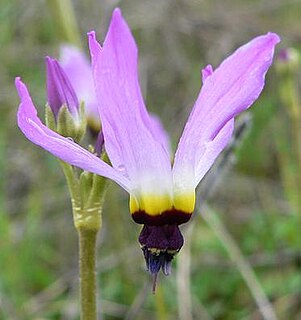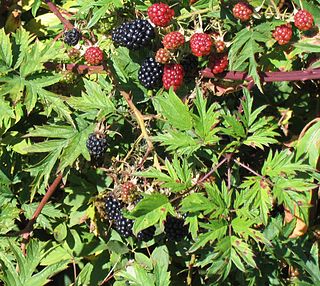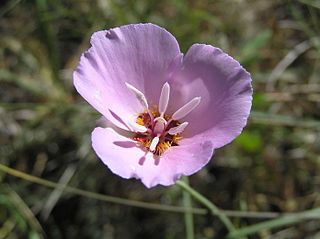
Rubus idaeus is a red-fruited species of Rubus native to Europe and northern Asia and commonly cultivated in other temperate regions.

Rubus spectabilis, the salmonberry, is a species of bramble in the rose family Rosaceae, native to the west coast of North America from west central Alaska to California, inland as far as Idaho. Like many other species in the genus Rubus, the salmonberry plant bears edible fruit, typically yellow-orange or red in color, resembling raspberries in appearance.

Rubus parviflorus, commonly called thimbleberry, is a species of Rubus native to northern temperate regions of North America. It bears edible red fruit similar in appearance to a raspberry, but shorter, almost hemispherical. Because the fruit does not hold together well, it has not been commercially developed for the retail berry market, but is cultivated for landscapes. The plant has large hairy leaves and no thorns.

Rubus leucodermis, also called whitebark raspberry, blackcap raspberry or blue raspberry, is a species of Rubus native to western North America, from Alaska south as far as California, Arizona, New Mexico, and Chihuahua.

Primula clevelandii, with the common name of Padre's shooting star, is a species of primrose.

Rubus pensilvanicus, known commonly as Pennsylvania blackberry, is a prickly bramble native to eastern and central North America from Newfoundland south to Georgia, west as far as Ontario, Minnesota, Nebraska, and Arkansas. The species is also established as a naturalized plant in California.

Rubus laciniatus, the cutleaf evergreen blackberry or evergreen blackberry, is a species of Rubus, native to Eurasia. It is an introduced species in Australia and North America. It has become a weed and invasive species in forested habitats in the United States and Canada, particularly in the Northeast and along the Pacific Coast.

Rubus armeniacus, the Himalayan blackberry or Armenian blackberry, is a species of Rubus in the blackberry group Rubus subgenus Rubus series Discolores Focke. It is native to Armenia and Northern Iran, and widely naturalised elsewhere. Both its scientific name and origin have been the subject of much confusion, with much of the literature referring to it as either Rubus procerus or Rubus discolor, and often mistakenly citing its origin as western European. Flora of North America, published in 2014, considers the taxonomy unsettled, and tentatively uses the older name Rubus bifrons.

Rubus ursinus is a North American species of blackberry or dewberry, known by the common names California blackberry, California dewberry, Douglas berry, Pacific blackberry, Pacific dewberry and trailing blackberry.

Ambrosia chenopodiifolia is a species of ragweed known by the common names San Diego bursage and San Diego bur ragweed. It is native to the Mexican states of Baja California and Baja California Sur, as well as to Orange and San Diego Counties it int US State of California. It is a member of the coastal sage scrub plant community.
Balsamorhiza macrolepis is a species of flowering plant in the sunflower tribe of the aster family, known by the common name California balsamroot. It is found only in California, where it grows in dry, open habitat, mostly in mountainous areas, mostly in the western foothills of the Sierra Nevada and in the eastern Coast Ranges near San Francisco Bay. It is now becoming rare in the Coast Ranges.

Blepharizonia plumosa is a California species of tarweed known by the common name big tarweed. It is endemic to central California, where it grows in the Central Coast Ranges and adjacent sections of the southern San Francisco Bay Area and Central Valley, from southern Sonoma County south as far as San Luis Obispo County.

Calochortus palmeri is a species of flowering plant in the lily family known by the common names Palmer's mariposa lily and strangling mariposa.

Chaenactis nevadensis, with the common name Nevada dustymaiden, is a North American species of flowering plant in the daisy family.
Chaenactis parishii is a species of flowering plant in the daisy family known by the common name Parish's chaenactis.

Rubus nivalis, commonly known as snow raspberry, is a species of flowering plant in the rose family. It is native to northwestern North America: British Columbia, Washington, Idaho, and far northern California.

Rubus lasiococcus is a species of wild blackberry known by the common names roughfruit berry and dwarf bramble. It is native to western North America from British Columbia to northern California, where it grows in mountain forests. In the southern half of its range the plant is commonly found in a plant community in the understory of mountain hemlock and Shasta red fir.

Rubus ulmifolius is a species of wild blackberry known by the English common name elmleaf blackberry or thornless blackberry and the Spanish common name zarzamora. It is native to Europe and North Africa, and has also become naturalized in parts of the United States, Australia, and southern South America.

Rubus pubescens is a herbaceous perennial widespread across much of Canada and the northern United States, from Alaska to Newfoundland, south as far as Oregon, Colorado, and West Virginia.

Drymocallis glandulosa, known by the common name sticky cinquefoil and formerly as Potentilla glandulosa, is a plant species in the family Rosaceae.

















